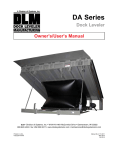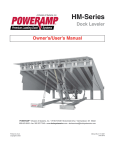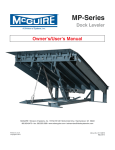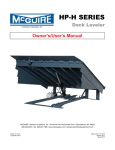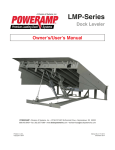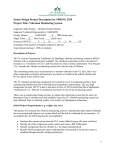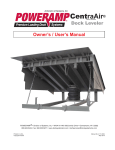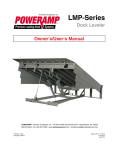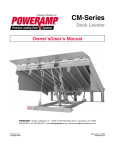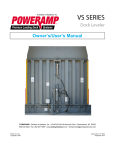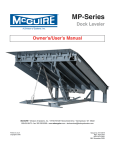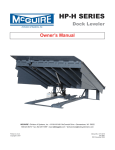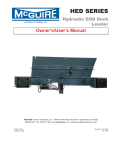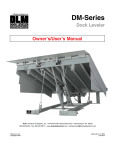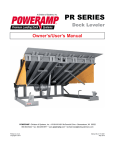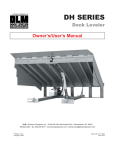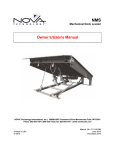Download “MA” SERIES Owner/User Manuall
Transcript
MA Series Dock Leveler Owner’s/User’s Manual W.B.MCGUIRE • Division of Systems, Inc. • W194 N11481 McCormick Drive • Germantown, WI 53022 800.624.8473 • fax: 262.257.7399 • www.docksystemsinc.com • [email protected] Printed in U.S.A. Copyright © 2008 Manual No. 4111-0021 November 2009 Table of Contents Page Safety Recognize Safety Information . . . . . . . . . . . . . . . . . . . . . . . . . . . . . . . 1 General Operational Safety Precautions . . . . . . . . . . . . . . . . . . . . . . 1 Operational Safety Precautions . . . . . . . . . . . . . . . . . . . . . . . . . . . . . 2 Maintenance Safety Precautions . . . . . . . . . . . . . . . . . . . . . . . . . . . . 4 Safety Decals . . . . . . . . . . . . . . . . . . . . . . . . . . . . . . . . . . . . . . . . . . . . 5 Introduction General Information . . . . . . . . . . . . . . . . . . . . . . . . . . . . . . . . . . . . . . . 6 Dock Leveler Stock Specifications . . . . . . . . . . . . . . . . . . . . . . . . . . . 6 Component Identification . . . . . . . . . . . . . . . . . . . . . . . . . . . . . . . . . . 7 Theory . . . . . . . . . . . . . . . . . . . . . . . . . . . . . . . . . . . . . . . . . . . . . . . . . 7 Installation Prepare Pit . . . . . . . . . . . . . . . . . . . . . . . . . . . . . . . . . . . . . . . . . . . . . . . 8 Prepare Dock Leveler . . . . . . . . . . . . . . . . . . . . . . . . . . . . . . . . . . . . . 9 Install Dock Leveler . . . . . . . . . . . . . . . . . . . . . . . . . . . . . . . . . . . . . . 10 Install Control Panel and Wiring . . . . . . . . . . . . . . . . . . . . . . . . . . . . 16 Put New Leveler Into Service . . . . . . . . . . . . . . . . . . . . . . . . . . . . . . 17 Operation Operating Instructions . . . . . . . . . . . . . . . . . . . . . . . . . . . . . . . . . . . . 18 Ramp Loading/Unloading Instructions . . . . . . . . . . . . . . . . . . . . 19 End Loading/Unloading Instructions . . . . . . . . . . . . . . . . . . . . . 20 Maintenance Service Dock Leveler Safely . . . . . . . . . . . . . . . . . . . . . . . . . . . . . . . 21 Periodic Maintenance . . . . . . . . . . . . . . . . . . . . . . . . . . . . . . . . . . . . . 22 Adjustments Adjust Lip Latch and Lip Actuator Springs . . . . . . . . . . . . . . . . . . . 24 Adjust Lip Stop . . . . . . . . . . . . . . . . . . . . . . . . . . . . . . . . . . . . . . . . . . 27 Troubleshooting Troubleshooting . . . . . . . . . . . . . . . . . . . . . . . . . . . . . . . . . . . . . . . . . 28 Electrical Electrical 115/1 phase . . . . . . . . . . . . . . . . . . . . . . . . . . . . . . . . . . . . . 30 Parts Controls . . . . . . . . . . . . . . . . . . . . . . . . . . . . . . . . . . . . . . . . . . . . . . . . 31 Pit Extension Kit . . . . . . . . . . . . . . . . . . . . . . . . . . . . . . . . . . . . . . . . . 32 Air Bladder and Support . . . . . . . . . . . . . . . . . . . . . . . . . . . . . . . . . . 33 Frane and Platform . . . . . . . . . . . . . . . . . . . . . . . . . . . . . . . . . . . . . . . 34 Weather Seal, Rubber Style . . . . . . . . . . . . . . . . . . . . . . . . . . . . . . . . 36 Weather Seal, Brush Style . . . . . . . . . . . . . . . . . . . . . . . . . . . . . . . . . 37 Motor and Blower Assembly . . . . . . . . . . . . . . . . . . . . . . . . . . . . . . 38 Miscellaneous Customer Information . . . . . . . . . . . . . . . . . . . . . . . . . . . . . . . . . . . . 39 Warranty . . . . . . . . . . . . . . . . . . . . . . . . . . . . . . . . . . . . . . . . Back Cover 4111-0021 — November 2009 SAFETY Recognize Safety Information General Operational Safety Precautions Safety-Alert Symbol The Safety-Alert Symbol identifies important safety messages on equipment, safety signs, in manuals, or elsewhere. When you see this symbol, be alert to the possibility of personal injury or death. Follow the instructions in the safety message. Read and understand the operating instructions and become thoroughly familiar with the equipment and its controls before operating the dock leveler. Never operate a dock leveler while a safety device or guard is removed or disconnected. The use of the word DANGER signifies the presence of an extreme hazard or unsafe practice which will most likely result in severe injury or death. The use of the word WARNING signifies the presence of a serious hazard or unsafe practice which may result in serious injury or death. The use of the word CAUTION signifies possible hazard or unsafe practice which could result in personal injury. IMPORTANT The use of the word IMPORTANT is to draw attention to a procedure that needs to be followed to prevent machine damage. Never remove DANGER, WARNING, or CAUTION signs or decals on the equipment unless replacing them. e Op in g rat ne Zo g tin era p O ne Zo Do not start the equipment until all unauthorized personnel in the area have been warned and have moved outside the operating zone. Remove any tools or foreign objects from the operating zone before starting. Keep the operating zone free of obstacles that could cause a person to trip or fall. 4111-0021 — November. 2009 1 SAFETY Operational Safety Precautions Learn the safe way to operate this equipment. Read and understand the manufacturer's instructions. If you have any questions, ask your supervisor. Stay clear of dock leveling device when freight carrier is entering or leaving area. Chock/restrain all freight carriers. Never remove the wheel chocks until loading or unloading is finished and truck driver has been given permission to drive away. Do not move or use the dock leveling device if anyone is under or in front of it. Do not use a broken or damage dock leveling device. Make sure proper service and maintenance procedures have been performed before using. Keep hands and feet clear of pinch points. Avoid putting any part of your body near moving parts. Make sure lip overlaps onto trailer at least 4 in. (102 mm). Keep a safe distance from both side edges. 2 4111-0021 — November 2009 SAFETY Do not use dock leveling device if freight carrier is too high or too low. Do not overload the dock leveling device. Do not operate any equipment while under the influence of alcohol or drugs. Do not leave equipment or material unattended on dock leveling device. 4111-0021 — November. 2009 3 SAFETY Maintenance Safety Precautions ALWAYS disconnect electrical power source and ground wire before welding on dock leveler. DO NOT ground welding equipment to any hydraulic or electrical components of the dock leveler. Always ground to the dock leveler frame. Failure to follow these instructions may result in damage to dock leveler and/or serious personal injury or death. Hydraulic and electrical power must be OFF when servicing the equipment. For maximum protection, use an OSHA approved locking device to lock out all power sources. Only the person servicing the equipment should have the key to unlock the device. DO NOT grind or weld if hydraulic fluid or other flammable liquid is present on the surface to be ground or welded DO NOT grind or weld if uncontained hydraulic fluid or other flammable liquid is present. Stray sparks can ignite spills or leaks near the work area. Always clean up the oil leaks and spills before proceeding with grinding or welding. Always keep a fire extinguisher of the proper type nearby when grinding or welding. Always post safety warnings and barricade the work area at dock level and ground level to prevent unauthorized use of the unit before maintenance is complete. Failure to follow these instructions may result in serious personal injury or death. ALWAYS stand clear of dock leveler lip when working in front of the dock leveler. Failure to do this may result in serious personal injury or death. The maintenance prop must be in the upright "service" position when working under the dock leveler. For maximum protection, use an OSHA approved locking device to lock the maintenance prop in the service position. Only the person servicing the equipment should have the key to unlock the device. 4 4111-0021 — November 2009 SAFETY Safety Decals Every 90 days (quarterly) inspect all safety labels and tags to ensure they are on the dock leveler and are easily legible. If any are missing or require replacement, please call 1-800-643-5424 for replacements. DANGER CRUSH HAZARD Maintenance prop must support leveler behind bar. Do not force maintenance prop forward of bar to support lip. Refer to owner’s/user’s manual for proper use. Failure to comply will result in death or serious injury. 1751-0727 1751-0727 1751-0730 (x2) DANGER SAFETY INFORMATION Unsupported dock leveler ramps can lower unexpectedly. Before allowing vehicle to leave the dock always: ! Ensure that no equipment, material or people are on the dock leveler. ! Return the dock leveler to its stored position at dock level. Failure to follow posted instructions will result in death or serious injury. Operation 1. Read and follow all instructions and warnings in the owner’s/user’s manual. 2. Use of dock leveler restricted to trained operators 3. Always chock trailer wheels or engage truck restraint before operating dock leveler or beginning to load or unload. 4. Never use hands or equipment to move the ramp or lip 5. Before activating dock leveler: ¥ Ensure trailer is backed in against bumpers. ¥ Remove any end loads if required. ¥ Check trailer alignment to avoid lip interference. If lip does not lower to trailer bed, reposition vehicle. 6. Ensure that truck bed supports extended lip or the leveler frame supports the ramp before driving on ramp. 7. Stay clear of hinges and front and sides of moving dock leveler. 8. Never use damaged or malfunctioning dock leveler. Report problems immediately to supervisor. Maintenance/Service 1. Read and follow all instructions, warnings and maintenance schedules in the owner’s/user’s manual. 2. Maintenance/Service of dock leveler restricted to trained personnel. 3. Place barriers on the driveway and on dock floor to indicate service work is being performed. 4. DO NOT ENTER PIT unless dock leveler is securely supported by maintenance prop. 5. If electrically powered turn off and use OSHA lockout/tagout procedures. Call 262.255.1510 for replacement placards, warning labels, or owner’s/user’s manuals. (decal placed in same position on both sides) 1751-0329 (x2) DO NOT FORK THIS SIDE (decal placed in same position on both sides) FORK HERE 1751-0330 (x2) (decal placed in same position on both sides) 1751-0729 DANGER CRUSH HAZARD Do not work under dock leveler unless this maintenance prop has been secured in the upright position. See owner’s/user’s manual for proper procedures. Failure to comply 1751-0729 will result in death or serious injury. DANGER 1751-0731 CRUSH HAZARD Open the pin latch and insert through the maintenance prop housing and prop completely. Close the pin latch to secure prop. Use every time dock leveler is serviced. Failure to comply will result in death or serious injury. 1751-0731 DANGER 1751-0726 CRUSH HAZARD DO NOT ENTER PIT unless dock leveler is safely supported by maintenance prop. Place barriers on driveway and dock floor to indicate service work being performed. Refer to owner’s/user’s manual for proper maintenance procedures. Failure to comply will result in death or serious injury. 1751-0726 4111-0021 — November. 2009 5 INTRODUCTION General Information Dock Leveler Stock Specifications MA-Series dock levelers are available in the following sizes, weight capacities, and options: Width: MA 6 ft (1828.8 mm) 6-1/2 ft (1981.2 mm) 7 ft (2133.6 mm) Length 6 ft (1828.8 mm) 8 ft (2438 mm) 10 ft (3048 mm) Congratulations on your choice of a McGUIRE dock leveler. This manual covers the Air Bag, MA model air powered dock leveler. Designed by McGUIRE to be a marvel of simplicity and efficiency, your dock leveler, when properly installed, will provide many years of trouble-free performance with an absolute minimum of maintenance. Its revolutionary air bag system efficiently controls and operates every function. To obtain maximum performance and longest possible use, a simple program of preventive maintenance is recommended. Capacity (CIR*) 25,000 lb (11,340 kg) 30,000 lb (13,608 kg) 35,000 lb (15,876 kg) 40,000 lb (18,144 kg) 45,000 lb (20,412 kg) 55,000 lb (22,680 kg) * CIR (Comparative Industry Rating) All docks are available in 115V motors only. The MA dock leveler comes equipped with an electrical control panel, which allows push button operation of the dock leveler functions. Each MA dock leveler unit and control panel has been factory prewired and tested to ensure satisfactory operation. To illustrate which connections are to be made in the field at installation, electrical drawings are included with each order or by contacting Poweramp Technical Services. Once again, thank you and congratulations on your purchase of a McGUIRE MA dock leveler. 6 4111-0021 — November 2009 INTRODUCTION O Component Identification A C P N D B J H G K F I A — Lip E — Lip Maintenance Prop Pivot) B — Lip Assist Rod F — Lip Actuator Snubber Spring C —Lip Linkage Assembly G — Lip Actuator Chain D — Lip Latch Assembly E H — Air bag support pallet I — Lip Keepers (2 used) J — Air bag K — Main Frame L M L — Maintenance Prop M —Blower Motor N —Toe Guard (2 used) O —Raise Button P —Safety Legs THEORY The MA dock leveler uses a blower motor and one-button operation for ease of use. The dock leveler can be operated remotely using the RAISE button (O) on the control panel . This activates an electric blower motor (M). The blower forces air into the air bag (J), causing the platform to rise. Releasing the RAISE button allows the platform to lower. When the platform rises to the point where there is 2 — 3 in. (51 — 76. mm) from its full raised height, the lip spring (F) and lip actuator chain (G), causes the lip linkage assembly to push the lip out and up. The lip assist spring (not shown) also helps keep the lip extended. When the lip is fully extended, the lip latch cable engages the lip latch assembly, locking the lip in the extended position. The dock leveler has reached its full height when the lip is fully extended. 4111-0021 — November. 2009 To lower the platform, release the Raise button (O). The platform will lower until the extended lip rests on the truck bed. If the lip did not fully extend or there is no truck at the dock the platform will lower until one of the following conditions occur: -- Lip is resting on lip keepers (cross-traffic position). -- Leveler went to the below-dock position, lip folds automatically, leveler rests on the safety legs (below dock position). -- Leveler went to the below dock position with operator holding the safety leg retract cable (not shown), safety legs are retracted, lip folds automatically causing dock to rest in the full below dock position. 7 INSTALLATION Prepare Pit 14” A C B 10” D A—Distance (Pit Width) (Front and Rear) B— Distance (Dock Floor-to-Pit Floor) (All Four Corners) C— Distance (Pit Length) (Both Sides of Pit) D— Distance (Pit Corner-to-Corner) (Top, Bottom, and Both Sides) Before lowering the dock leveler into the pit, the following must be performed: Post safety warnings and barricade the work area at dock level and ground level to prevent unauthorized use of the dock leveler before installation has been completed. Failure to follow the installation instructions can result in damage to dock leveler, the facilities, and/or serious personal injury or death. Only trained installation professionals with the proper equipment should install this product. IMPORTANT DO NOT remove the shipping bands around the dock leveler lip until instructed to do so. 1. Remove all debris from the pit and sweep the pit clean. 2. Check the entire dock leveler pit for proper construction according to approved/certified pit drawings. Make sure pit is square by making the following measurements: • Measure pit width distance (A) at both front and rear of pit. • Measure dock floor-to-pit floor distance (B) at all four corners. • Measure pit length distance (C) at both sides. • Measure corner-to-corner (criss-cross) distance (D) at both sides. Take measurements at dock floor level and at pit floor level. If any measurement is off by more than 1/8 in. (3.18 mm), contact Poweramp Technical Services before proceeding. 3. Make sure the field junction box for the dock leveler (E) is at the correct location per pit diagrams. 8 4111-0021 — November 2009 INSTALLATION Prepare Dock Leveler IMPORTANT DO NOT remove the shipping bands (B) around the platform lip and leveler frame at this time. The shipping bands are needed to hold the leveler together during the installation process. A 1. Remove any control panel and bumpers that may be banded to the frame of the dock leveler. DO NOT remove the shipping bands (B) around the platform lip and leveler frame at this time. IMPORTANT B A— Lifting Bracket (2 used) DO NOT over tighten the lifting bracket hardware. Over tightening can damage the weather seal, if equipped. B — Shipping Bands McGUIRE dock levelers are designed with installation in mind. Each unit is shipped with lifting brackets (A) fastened to the platform side joists. NOTE: Overall width of platform and lifting brackets (A) must be kept to a minimum to prevent interference between the lifting brackets and the pit walls as the dock leveler is lowered into the pit. The dock leveler is heavy. Use a lifting device and chains with the appropriate lifting capacity and reach. 2. Make sure the mounting hardware of lifting brackets (A) is snug. The brackets should pivot relatively freely on the mounting cap screw. DO NOT over tighten. Always use the lifting brackets provided with the unit whenever lowering or lifting a dock leveler into or out of a pit. 3. Attach lifting chains to lifting brackets (A) and to a lifting device (i.e., hoist or fork truck) having the appropriate lifting capacity and reach. Failure to follow these instructions may result in damage to dock leveler and/or serious personal injury or death. 4. Remove wood blocks that are attached to the leveler frame before putting the dock leveler into the pit. 5. Attach a temporary, switched, power supply to the blower before lowing leveler into pit. Keep power cables clear of frame members, shim locations and pinch points. DO NOT CONNECT POWER AT THIS TIME. 4111-0021 — November. 2009 9 INSTALLATION Install Dock Leveler Shim Stacking Methods N P Q R A— Distance (Leveler Frame Height) B— Shim Locations (Under Rear Vertical Supports, 4-5 Places TYP) C— Shim Locations (Under Lip Keepers, C —Shim Under Snubber Spring Mount D— Dock Floor E— Rear Pit Curb Angle 10 F— String G— Rear Hinge Frame Angle H— Distance (Dock Floor-toPit Floor) J— Distance (Top of Shim Stack-to-Dock Floor) K— Shim Stack L— Dock Leveler Frame M — Pyramid (Preferred) N— Stepped (Acceptable) P— Offset (Not Acceptable) Q — Straight (Not Acceptable) 4111-0021 — November 2009 INSTALLATION NOTE: McGUIRE dock levelers are designed with a nominal 1/2 in. (12.7 mm) shimming distance to allow for pit inconsistencies. 4. For all MA models, put a 1/4 in. (6.6 mm) thick shim at locations (B and C) . 1. Determine height of shim stack (L) for each shim location (B) by performing the following: NOTE: A 1/4 in. (6.6 mm) thick shim at locations (B and C) is used only as a starting point. The final shim stack height will be determined after dock leveler is lowered into the pit. a. Measure leveler frame height distance (A). b. Measure dock floor-to-pit floor distance (J) at each shim location (B). Write down the dimensions obtained at each location. c. Subtract distance (A) from distance (J) to obtain the shim height. Repeat for each shim location. IMPORTANT The minimum size of the shim that contacts the leveler frame (i.e., the top shim of each shim stack) must be at least 4-1/2 x 4-1/2 in. (114.3 x 114.3 mm) to support the full width of the frame rail and to provide a shelf for a fillet weld. Use the thickest shim stock possible for stability and weld penetration purposes. DO NOT use multiple layers of 1/8 in. (3.18 mm) or thinner shim stock. 2. Using the results obtained in step 1, create the individual shim stacks on the pit floor at locations (B). Build each shim stack (L) using the pyramid method (N) (preferred) or stepped method (P) with the top shim having a minimum size of 4-1/2 x 4-1/2 in. (114.3 x 114.3 mm) and each successive lower shim being larger so the shims can be welded together using a fillet weld. DO NOT use offset method (Q) or straight method (R). The dock leveler is heavy. Use chains and a lifting device with the appropriate lifting capacity and reach. Failure to do so may result in damage to dock leveler and/or serious personal injury or death. 5. Using an appropriate lifting device connected to the lifting brackets, lower dock leveler into the pit so rear hinge frame angle (G) is tight against rear pit curb angle (E) across full width of the leveler frame. 6. Allow rear of dock leveler to rest on the rear shims while keeping the front of the dock leveler level with the dock floor. 7. For all MA models, add shims at front shim locations (C) so front of dock leveler will stay level with dock floor when leveler is resting fully on shims. NOTE: To assist in obtaining an accurate measurement of distance (K), use a string (G) pulled tight across the pit opening, directly over the shim locations. 3. Verify that each shim stack is at the correct height by measuring distance (K) [top of shim stack (L) to dock floor]. Distance (K) must equal the dock leveler height (A). 4111-0021 — November. 2009 11 INSTALLATION B A C C D D E F G A— Front of Dock Pit B— Dock Leveler Frame 3/8 in. (9.5 mm) 6 in. (152 mm) C— Side Pit Curb Angle D— Gap [3/4 in. (19 mm) Minimum] 8. With rear hinge frame angle (F) tight against rear pit curb angle (G), perform/check the following: • Pry between the platform and rear hinge frame angle at locations (E) to make sure rear edge of platform is parallel to the rear hinge frame angle (F). • Gap (D) must exist equally along both sides of leveler so weather seal (if equipped) will not bind during dock leveler operation. 12 H E— Pry Locations G— Rear Pit Curb Angle F— Rear Hinge Frame Angle H— Flare Bevel Weld, Typical (To Fit Spacing) 9. If gap (D) cannot be obtained equally at both sides of leveler, grind or add material at the rear edge of rear hinge frame angle (F) as needed. 10. Allow the dock leveler to rest fully on the shim stacks. Check that a smooth and level transition exists between the dock floor and the dock leveler platform. Add or remove shims as necessary until a smooth transition is obtained. 11. If leveler cannot be squared and/or made level as instructed in steps 8 — 10, contact McGUIRE Technical Services. 4111-0021 — November 2009 INSTALLATION 12.With the leveler square in the pit and flush with the surrounding dock, remove the banding on the lip of the leveler. 13. Connect the blower motor to the temporary power supply. Two people are required to engage the maintenance prop: one person to operate the lifting device, the other person to engage the maintenance prop. 14. Slowly raise the platform. Check for binding as platform is being raised. 15. If binding occurs, lower the platform. Reposition leveler and/or add or remove shims as necessary. Slowly raise platform again. If platform still binds, contact Poweramp Technical Services for further instructions. 16. All MA models - Once leveler is flush, square and does not bind: a. Install shims under maintenance prop (C) page 10, where prop attaches to leveler frame. Make sure prop is solidly shimmed. DO NOT use the maintenance prop to support the raised platform until the maintenance prop has been properly shimmed and welded. The shims must be welded to each other, the leveler frame, and to the front pit curb steel. Failure to do this may result in serious personal injury or death. c.Raise maintenance prop to the service (upright) position and lock prop in this position using an OSHA approved locking device. 17. Disconnect power supply from motor. b. Using the leveler’s blower motor, raise the dock to the fully open position. IMPORTANT DO NOT weld before disconnecting all electrical components. DO NOT weld before removing air bag, air bag support pallet and hoses from leveler. Protect or remove the blower motor before welding. figure 1 Failure to follow these instructions may result damage to these components from stray sparks and weld splatter that will void your warranty. 18. Remove air bag and pallet support from the leveler by disconnecting air bag positioning rods from hooks on the underside of platform.(figure 1) and removing the band clamp from the motor coupler. (figure 2) 19. Remove or protect the blower motor from weld sparks and splatter. Proceed to step 17. figure 2 4111-0021 — November. 2009 13 INSTALLATION IMPORTANT DO NOT grind or weld if hydraulic fluid or other flammable liquid is present on the surface to be ground or welded. DO NOT grind or weld if uncontained hydraulic fluid or other flammable liquid is present. Stray sparks can ignite spills or leaks near the work area. Always clean up the oil leaks and spills before proceeding with grinding or welding. Always keep a fire extinguisher of the proper type nearby when grinding or welding. Failure to follow these instructions may result in serious personal injury or death. IMPORTANT DO NOT connect the dock leveler electrical wiring and ground connections until all welding has been completed. DO NOT weld continuously along the full length of the rear hinge frame angle. This can put unnecessary stress on the leveler components, causing the leveler to malfunction and shorten the life span of the affected components. NOTE: The illustration on page 12 shows a typical weld pattern. The weld pattern will vary slightly depending on size of dock leveler. 20. With the rear hinge frame angle (F) tight against the rear pit curb angle and flush with the curb angle (G), weld the rear hinge frame angle (F) to the rear pit curb angle (G) using a 3/8 in. (9.5 mm) flare bevel skip weld — each weld being 6 in. (152 mm) long. Start at each end with a 6 in. (152 mm) long weld. Space all the other welds out evenly leaving approximately 6 in. (152 mm) space between each weld. DO NOT ground welding equipment to any hydraulic or electrical components of the dock leveler. Always ground welding equipment to the dock leveler frame, NEVER to the platform. Failure to follow these instructions may damage the motor, wiring, and/or control panel. 14 4111-0021 — November 2009 INSTALLATION Make sure the platform is properly supported in the raised position before entering the pit to finish weld the shims. Failure to do this may result in serious personal injury or death. 21. All model levelers: Install shims at locations (B, p.10) using the pyramid or stepped shimming method. Make sure the platform is level from side-to-side as well as from front-to-back and flush with dock floor. 22. Weld front of dock leveler frame (C) to shims located under the keepers, then weld the shims to the front pit curb steel. 23. Finish weld all shims using a fillet weld. • Weld all shims within each shim stack to each other, then weld the shim stack to the leveler frame. • Weld the front leveler frame shim stacks to the front pit curb steel. 24. When all welding has been completed, paint all the welds and shims. Shim Stacking Methods N P Q R * For left/right orientation of dock leveler, see inside back cover of this manual. 4111-0021 — November. 2009 15 INSTALLATION Install Control Panel and Wiring A The electrical power must be OFF prior to electrical installation. For maximum protection, use an OSHA approved locking device to lock out all power sources. Only the person installing the equipment should have the key to unlock the power source. Failure to follow these instructions may result in serious personal injury or death. B C DO NOT make any final electrical connections until all welding has been completed. Failure to do this may result in serious personal injury or death. All electrical work — including the installation of the disconnect panel, control panel, and final connections to the pit junction box — must be performed by a certified electrician and conform to all local and applicable national codes. A— Disconnect Panel (provided by others) B— Control Panel C— Distance, 48 in. (14 630 mm) 1. Mount the push button control panel (B) so bottom of control panel-to-dock floor distance (C) is 48 in. (1219.2 mm). 2. Install electrical disconnect panel (A) if not already installed. 3. Install and connect the control wiring. 4. Re-install the air bag, air bag support pallet and blower motor. 5. Connect the dock leveler power cable to the outlet in the pit junction box. Refer to the electrical drawings supplied with the dock leveler. 6. After all electrical connections in the pit have been made, raise the leveler, disengage the maintenance prop and allow the platform to lower. 16 4111-0021 — November 2009 INSTALLATION Put New Dock Leveler Into Service 1. Disconnect the external lifting device and chains from the lifting brackets. 2. Check that the leveler is flush with the dock floor and that the platform lip contacts both lip keepers evenly. If an excessive transition exists between the dock floor and leveler and/or lip does not contact both lip keepers evenly, contact Poweramp Technical Services for further instructions. 7. When the platform lowers to the full below-dock position, the lip will fold. Push and hold the RAISE button until the platform rises just enough to clear the lip keepers, then release the RAISE button to allow the platform to lower to the cross-traffic (stored) position (lip engages lip keepers). 8. Perform steps 5 – 7 at least four times make sure the leveler functions properly and there is no binding. 3. Install the dock bumpers as required. 4. Turn the main electrical power ON. Always stand clear of platform lip when working in front of the dock leveler. Serious personal injury or death may result. 5. Raise the leveler platform fully by pushing and holding the RAISE button . NOTE: The platform of a properly operating dock leveler will automatically stop rising when it reaches approximately 2 – 3 inches from its full raised height, at which point, the lip extends. When the lip is fully extended, it has reached the full raised position. (If the lip does not extend or extend fully, see Platform Rises to Full Height, But Lip Does Not Fully Extend in the Troubleshooting section.) 6. Release the RAISE button to lower the platform. As long as there is no truck present at the dock, the platform will lower to the full below-dock position as the lip folds. NOTE: If a truck is present, the platform will lower until the lip rests on the truck/trailer bed. (See Operating Instructions in Operation section.) 4111-0021 — November. 2009 Unless the dock leveler is equipped with a tethered remote, two people are required to engage the maintenance prop: one person to operate the unit, the other person to engage the maintenance prop. 9. Raise the platform fully. Hold the platform at this position using the RAISE button and move the maintenance prop to the service (upright) position. Release the RAISE button to allow the platform to lower until it is resting on the maintenance prop. 10. With the maintenance prop supporting the platform, remove the lifting brackets 11. If equipped with vertical weather seals, position the seals so that the seals are directly under and aligned with the overhead door. 12. Support the toe guards, remove the bolt used in shipping and carefully release the toe guards. 13. Push and hold the RAISE button until the maintenance prop drops to its stored position. Release the RAISE button and allow the platform to lower fully. Check operation of toe-guards. 14. When the platform lowers to the full below-dock position, the lip will fold. Push and hold the RAISE button until the platform rises just enough to clear the lip keepers, then release the RAISE button to allow the platform to lower to the cross-traffic (stored) position (lip engages lip keepers). 17 OPERATION Operating Instructions Stay clear of dock leveler when freight carrier is entering or leaving dock area. 12 in. (305 mm) DO NOT move or use the dock leveler if anyone is under or in front of leveler. 12 in. (305 mm) Keep hands and feet clear of pinch points. Avoid putting any part of your body near moving parts. Failure to follow these instructions may result in severe personal injury or death. Only trained personnel should operate the dock leveler. The MA pneumatic dock leveler is designed to compensate for a maximum ± 12 in.* (305 mm) of height difference between the loading dock and the truck bed. DO NOT use the dock leveler if the truck/trailer bed is more than 12 in. (305 mm) higher or lower than the dock floor. *service height may vary with design specifications DO NOT overload the dock leveler. DO NOT use a broken or damaged dock leveler. Make sure proper service and maintenance procedures have been performed on leveler before using. Truck/trailer wheels must be chocked unless the truck restraint is used. Never remove the wheel chocks until loading/unloading is finished and truck driver has been given permission to leave. Make sure platform lip rests on the truck/trailer bed with at least 4 in. (102 mm) of overlap. Maintain a safe distance from side edges of leveler during the loading/unloading process. Failure to follow these instructions may result in serious personal injury or death. 18 DO NOT operate any equipment while under the influence of alcohol or drugs. DO NOT leave equipment or material unattended on the dock leveler. Failure to follow these instructions may result in personal injury and/or damage to equipment. The dock leveler operating instructions are divided into the two methods of loading and unloading: • For ramp loading and unloading, see Ramp Loading/Unloading Instructions on page 19. • For end loading and unloading, see End Loading/Unloading Instructions on page 20. 4111-0021 — November 2009 OPERATION Operating Instructions—Continued Below Dock Loading/Unloading Instructions Ramp Loading/Unloading Instructions NOTE: If end unloading is required, see End Loading/Unloading Instructions on page 20. NOTE: If end unloading is required, see End Loading/Unloading Instructions on page 20. 7. Check to make sure truck/trailer is positioned squarely against dock bumpers. For ramp loading or unloading, the MA dock leveler can be operated by using the RAISE button on the control panel. 8. Instruct driver to remain at the dock until the loading or unloading process has been completed. 1. Check to make sure truck/trailer is positioned squarely against dock bumpers. 9. Chock the truck/trailer wheels or use truck restraint if present. 2. Instruct driver to remain at the dock until the loading or unloading process has been completed. 10. Raise the platform by pushing the raise button (A) to fully raise the leveler and extend the lip. 3. Chock the truck/trailer wheels or use the truck restraint if available. 11. Walk out on the leveler, Pull and Hold the release ring (see picture below) until the platform lowers onto the trailer. Make sure there is a minimum of 4” of lip overlapping the trailer. A A-RAISE Button 4. Extend the platform lip onto truck/trailer as follows: a. Raise the platform by pushing and holding RAISE button . Loading/Unloading Completed - Reset Leveler b. Hold the RAISE button until the lip is fully extended, then release the RAISE button. The platform will lower until the lip is resting on the truck/trailer bed. c. Make sure that the lip is fully extended and supported on the truck/trailer along the entire width of the platform with at least 4 in. (102 mm) of lip contacting the truck bed. A A—RAISE Button 12. When loading or unloading is finished, raise the platform by pushing and holding RAISE button (A) . 13. Hold the RAISE button until the lip folds enough to clear the truck/trailer bed, then release the RAISE button. The lip will fold and the platform will return to the cross-traffic position. 5. Proceed with loading or unloading the truck/trailer. 6. If below dock loading is necessary, see steps 7-11. If not, proceed to step 12. 14. Remove chocks from truck/trailer wheels or release the truck restraint if used. 15. Indicate to driver that truck may leave the dock. 4111-0021 — November. 2009 19 OPERATION Operating Instructions—Continued End Loading/Unloading Instructions NOTE: If ramp loading is required, see Ramp Loading/Unloading Instructions on page 19. End loading or unloading can be done with the dock at the cross-traffic position or below-dock position, depending on the height of the truck/trailer bed. 1. Check to make sure truck/trailer is positioned squarely against dock bumpers. 2. Instruct driver to remain at the dock until the loading or unloading process has been completed. 3. Chock the truck/trailer wheels or use the truck restraint if available. 6. Push the Raise button to the platform high enough to clear the lip keepers, but not high enough to extend the lip. 7. Walk out on the leveler, pull and hold the safety leg retract pull ring (B) (located in the recess at the front of the platform). This will cause the lip to extend away from the lip keepers and the cross traffic safety legs to fold to allow the leveler to lower to the below dock position. 8. When the platform lip clears the lip keepers, continue to hold the pull chain as the leveler lowers to the below-dock service position. The platform will drift down to the full below-dock position. 9. Proceed with loading or unloading. End Loading/Unloading — Platform at Cross-Traffic Position. 4. If truck/trailer bed is at or above dock floor level, leave leveler at the cross-traffic position and proceed with loading or unloading. NOTE: When end unloading is finished and access to the rest of the truck/trailer is still required, the platform lip will need to be extended. See Ramp Loading/Unloading Instructions on page 19 for further instructions. 10. When the loading or unloading is finished, return the dock leveler platform to the cross-traffic (stored) position. End Loading/Unloading — Platform Too High Use Below-Dock Position. 5. If truck/trailer bed is below the dock floor level, perform steps 6 –12. 11. Push the Raise button (A) until the lip clears the lip keepers. Release Raise button, leveler will return to the stored or cross traffic position. 12. Remove chocks from truck/trailer wheels or release the truck restraint if used. 13. Indicate to the driver that the truck may leave the dock. End Loading/Unloading — Platform at Below-Dock Position. 20 4111-0021 — November 2009 MAINTENANCE Service Dock Leveler Safely E A— Maintenance Prop B —Prop Pin and Clip C —Safety Leg Chain When service under the dock leveler is required, always lock all electrical disconnects in the OFF position after raising the platform and engaging the maintenance prop. Failure to do this may result in serious personal injury or death. Always stand clear of the dock leveler lip when working in front of the dock leveler. The maintenance prop MUST be in the service position when working under the dock leveler. For maximum protection, use an OSHA approved locking device to lock the maintenance prop in the service position. Only the person servicing the equipment should have the key to unlock the maintenance prop. Unless the dock leveler is equipped with a tethered remote, two people are required to engage the maintenance prop: one person to operate the unit, the other person to engage the maintenance prop. Failure to follow these instructions may result in serious personal injury or death. 4111-0021 — November. 2009 D —Lip Prop E.— Lock Out Tag Out Always post safety warnings and barricade the work area at dock level and ground level to prevent unauthorized use of the dock leveler before maintenance is complete. Failure to do this may result in serious personal injury or death. Whenever performing maintenance under the dock leveler platform, support the platform with the maintenance prop (A). Position the maintenance prop behind front header plate while staying clear of the lip. The lip will fold down after the platform has rested on the maintenance prop. The Lip Prop may be used to keep the lip extended (D). Additional supports should be used to prevent the lip from collapsing if working under the leveler. Lock the maintenance prop in the service (B) position using an OSHA approved lockout/tagout device* (E). Whenever servicing the dock leveler, lock the electrical power disconnect in the OFF position. Use only an OSHA approved lockout/tagout device* (E). Only the person servicing the equipment should have the capability to remove the lockout/tagout devices. The Tag out devices* must inform that repairs are in process and clearly state who is responsible for the lockout condition. * Refer to OSHA regulation 1910.147. 21 MAINTENANCE Periodic Maintenance Always stand clear of the dock leveler lip when working in front of the dock leveler. The maintenance prop MUST be in the service position when working under the dock leveler. For maximum protection, use an OSHA approved locking device to lock the maintenance prop in the service position. Only the person servicing the equipment should have the key to unlock the maintenance prop. Unless the dock leveler is equipped with a tethered remote, two people are required to engage the maintenance prop: one person to operate the unit, the other person to engage the maintenance prop. Failure to follow these instructions may result in serious personal injury or death. Before performing any maintenance under the dock leveler, lock the electrical power source in OFF position and lock the maintenance prop in the service position using an approved locking device. (See Service Dock Leveler Safely in this section.) Under platform service Failure to follow these instructions may result in serious personal injury or death. Air Filter, service under rear of platform 22 4111-0021 — November 2009 MAINTENANCE Regular maintenance must be performed on a weekly and quarterly schedule. Weekly Maintenance Quarterly Maintenance • Operate the dock leveler through the complete operating cycle to maintain lubrication. • Perform Weekly Service Items NOTE: To thoroughly inspect the platform hinge area, put the platform in the full below-dock position. • Inspect the platform hinge and the lip hinge areas. The hinge areas must be kept free of dirt and debris. Build-up of foreign material in the hinge areas will cause abnormal operation. • Inspect the area under the platform, around and under the air bag. Build-up of foreign material in this area may damage air bag components, causing abnormal operation. • Lubricate the following areas with light weight machine oil: (A)— Lip hinge area unless equipped with grease fittings (apply oil to the top of the entire length of lip hinge when platform is at the full below-dock position and lip is folded) (B)— Platform hinge area (apply oil to top of all platform hinges when platform is at the full below-dock position) NOTE: Apply grease to lip hinge grease fittings if equipped. IMPORTANT Failure to properly lubricate the dock leveler will cause abnormal operation of the leveler. • Lubricate the following areas with light-weight machine oil: (C)— Lip maintenance prop pivot (D)— Lip link pivots (E)— Safety leg linkage pivots • Lubricate the following areas with white lithium grease (if equipped with grease fittings): (A)— Lip hinge area (inject grease into all the lip hinge grease fittings) (B)— Platform hinge area (inject grease into all the platform hinge grease fittings) (F)— Lip assist pin 4111-0021 — November. 2009 23 ADJUSTMENTS Adjusting the Latch and Lip Actuator Spring Tension When service under the dock leveler is required, always lock all electrical disconnects in the OFF position after raising the platform and engaging the maintenance prop. Failure to do this may result in serious personal injury or death. Always post safety warnings and barricade the work area at dock level and ground level to prevent unauthorized use of the dock leveler before maintenance is complete. Failure to do this may result in serious personal injury or death. A Always stand clear of the dock leveler lip when working in front of the dock leveler. B The maintenance prop and lip maintenance prop MUST be in the service position when working under the dock leveler. For maximum protection, use an OSHA approved locking device to lock the maintenance prop in the service position. Only the person servicing the equipment should have the key to unlock the maintenance prop. Unless the dock leveler is equipped with a tethered remote, two people are required to engage the maintenance prop: one person to operate the unit, the other person to engage the maintenance prop. A— Lip Latch Spring Adjustment B— Lip Assist Spring Adjustment Failure to follow these instructions may result in serious personal injury or death. 24 4111-0021 — November 2009 ADJUSTMENTS Adjusting Lip Latch Spring Tension Adjusting Lip Assist Spring Tension This adjustment is set at the factory and should not require additional adjustment. This adjustment is set at the factory and should not require additional adjustment. Unlike mechanical levelers, the lip will not immediately begin to fold as the platform returns to the stored position. Unlike mechanical levelers, the lip will not immediately begin to fold as the platform returns to the stored position. After the platform is fully raised, and the lip extends, the lip latch is designed to hold the lip in the extended position until the platform drifts down to the below dock position. The MA leveler lip remains extended as the platform drifts down to the below dock position. The lip will automatically fold when the platform when the dock is resting on the safety legs in the below dock position. If the lip does not remain extended as the platform lowers, additional spring tension may be required. If the lip does not fully extend additional spring tension may be needed. NOTE: Use half-turn increments when adjusting lip assist spring. Check lip operation after each adjustment. Repeat until proper operation is obtained. NOTE: Use two-turn increments when adjusting lip assist spring. Check lip operation after each adjustment. Repeat until proper operation is obtained. Adjust spring tension as follows: Adjust spring tension as follows: a. Loosen jam nut (A). a. Loosen jam nut (A). b. To increase spring tension, turn nut (B) counter clockwise. b. To increase spring tension, turn nut (B) clockwise. c. To decrease spring tension, turn nut (B) clockwise. c. To decrease spring tension, turn nut (B) counterclockwise. d. Tighten jam nut. d. Tighten jam nut. Recheck operation of platform and lip. Readjust lip latch spring tension and lip assist spring tension until proper operation is obtained. 4111-0021 — November. 2009 Recheck operation of platform and lip. Readjust lift spring tension and lip assist spring tension until proper operation is obtained. 25 This page intentionally left blank. 26 4111-0021 — November 2009 ADJUSTMENTS Adjust Lip Stop Bolt Always post safety warnings and barricade the work area at dock level and ground level to prevent unauthorized use of the dock leveler before maintenance is complete. Failure to do this may result in serious personal injury or death. A B Always stand clear of the dock leveler lip when working in front of the dock leveler. Failure to do this may result in serious personal injury or death. C E The platform maintenance prop MUST be in the service position when working under the dock leveler. For maximum protection, use an OSHA approved locking device to lock the maintenance prop in the service position. Only the person servicing the equipment should have the key to unlock the maintenance prop. Failure to follow these instructions may result in serious personal injury or death. D A— Platform Frame B— Jam Nut C— Stop Bolt D — Lip Keeper E — Lip Check that lip (E) is fully resting on the lip keepers (D) and at the lowest part of the keeper cradle. If lip is not resting properly in keepers, perform the following adjustment. 4. Tighten jam nut.(B) 1. Fully raise platform. Engage lip and maintenance prop. 6. Allow platform to lower to cross-traffic (stored) position. 2. Loosen jam nut (B). 7. Check lip position in both keepers. Repeat procedure if necessary. 5. Fully raise platform and disengage lip and maintenace prop. 3. Adjust stop bolt (C) as necessary. • Turn stop bolt “in” (clockwise) to allow lip to fold closer to platform frame (A). • Turn stop bolt “out” (counterclockwise) to hold lip further away from platform frame (A). 4111-0021 — November. 2009 27 TROUBLESHOOTING Troubleshooting Always stand clear of the dock leveler lip when working in front of the dock leveler. When service under the dock leveler is required, always lock all electrical disconnects in the OFF position after raising the platform and engaging the maintenance prop. Failure to do this may result in serious personal injury or death. The maintenance prop MUST be in the service position when working under the dock leveler. For maximum protection, use an OSHA approved locking device to lock the maintenance prop in the service position. Only the person servicing the equipment should have the key to unlock the maintenance prop. Always post safety warnings and barricade the work area at dock level and ground level to prevent unauthorized use of the dock leveler before maintenance is complete. Failure to do this may result in serious personal injury or death. Unless the dock leveler is equipped with a tethered remote, two people are required to engage the maintenance prop: one person to operate the unit, the other person to engage the maintenance prop. Failure to follow these instructions may result in serious personal injury or death. Before performing the detailed troubleshooting procedures, check the following items first: • Check all fuses inside the control panel(s). Replace any blown fuse(s) with a fuse of equal specification. Symptom • Make sure the correct voltages are present at the proper locations inside the control panel(s). Possible Cause Platform does not rise. Motor fuse blown. Motor does not energize. Motor failure Solution Reset circuit panel or disconnect fuse. Determine cause of overload. Check voltage to motor. • Platform does not rise. Motor hums, but does not run. Incorrect voltage is present on line. If voltage is present and motor does not energize, replace motor. • If voltage is not present, check all components in series with the motor. Check line for proper voltage • • • Platform does not rise. Motor energizes, but does not run. 28 Line voltage too low. • • • If proper voltage is not present, check all components in series with the motor. If proper voltage is present and motor does not run, check for obstructions. If no obstructions are found, replace motor. Check wiring to motor for high resistance. Check for loose or corroded connections. Check if gauge of wires to motor are of correct size and specification for load requirement. Replace if necessary. 4111-0021 — November 2009 TROUBLESHOOTING Symptom Platform rises slowly Possible Cause Solution Air bladder or connecting ducts punctured Check air bladder and ducting repair or replace as needed Damaged or restricted ducting Replace damaged ducting or remove restriction Air intake clogged Remove intake filter, clean or replace as needed Dock leveler binding Check for visible obstructions that could cause binding. Remove obstructions. If no obstructions found, call Poweramp Technical Services. See inside back cover for phone number and address. Platform does not rise to See Platform Rises Slowly full height. See Platform Rises Slowly See Periodic Maintenance in the Maintenance section. Platform DOES rise to full height, but lip DOES NOT extend or extend fully. Lip assist spring needs additional tension. Inspect lip actuator spring, replace as needed. Lip does not extend. Check the snubber spring assembly The chain is too long and needs to be shortened OPEN HEIGHT 42.5” for 6 foot and 47.5” for 8 foot long. The assembly is broken or missing. Lip extends almost Lip actuator chain caught on Inspect lip actuator chain, clean area, insure chain is immediately when the debris or framework. free from interference. RAISE button is pushed. Platform rises after lip is fully extended. Lip extends but does not Lip latch spring needs remain extended as additional tension. leveler drops. 4111-0021 — November. 2009 See Adjustment Section: Lip Latch Spring. • Increase tension as needed to keep latch engaged. • Clean any debris from lip latch area. • Lubricate as instructed in maintenance section. 29 ELECTRICAL 9-RO-800-A-A 30 4111-0021 — November 2009 PARTS Controls A 4 -1/2 B 2-7/8 3.00 11.8FLA Amp Draw Item Quantity Part Number Description A 1 7141-0207 Push Button Controller, B 1 1751-0725 Decal * Provide dock leveler serial number, voltage, phase, and options when calling or faxing controller orders. 4111-0021 — November. 2009 31 PARTS This Page Intentionally Left Blank 32 4111-0021 — November 2009 PARTS Airbag and Support Pallet Item Quantity Part Number 1 3 5812-0045 Hold Down Rod, 45” long x 7/16” diameter 2 1 5811-0009 Air Bag Bladder 3 1 5811-0012 Skid, Air Bag Leveler 4 2 5813-0001 Skid BRKT, Air Bag Leveler, BM 5 4 2101-0098 Screw, HHCS, 5/16-18UNC x 1-1/2 long 6 4 2101-0214 Nut, Flange, Top L/N, 5/16 - 18UNC 7 4 2101-0058 Washer, Lock 5/16 8 6 2101-0224 Rod Clamps 9 4 2101-0079 Washer Flat 1/2 inch 10 2 2101-0230 Ring, Split 1.75 O.D 3-10 1 5814-0029 Skid, Air Bag Leveler Assembly, Includes Items 3-10 4111-0021 — November. 2009 Description 33 PARTS Frame and Platform Item Quantity Part Number 1 2 3 4 5 1 1 1 2 2 2 2 1 1 1 1 1 1 1 1 8435-____ 7952-0001 0941-0013 2101-0217 8432-1129 8432-1130 2101-0047 DOTH-2555 DOTH-6839 DOTH-2421 9201-0006 9224-0030 9224-0031 9244-0079 2101-0216 6 7 8 9 10 11 1 Description Frame, Welded Assembly Cable A.C. Assembly 14.00 Final length Spring Lip Latch Ext. Link, Quick 1/4” Keeper Lip 16 inch Keeper Lip 18 inch Cotter Pin, 1/4 x 2 in. Spring, Snubber Linkage,Lip Assist W/SNUBBER Cold Shut Prop Pin and Clip. Maint. Prop 6 foot Maint. Prop 8 foot Maint. Prop 10 foot. Link, Quick 1/8” 1 CONSULT FACTORY 34 4111-0021 — November 2009 PARTS PLATFORMS1 6 FOOT ITEM QTY 1 8 FOOT 6.0 FOOT 6.5 FOOT 7.0 FOOT 6.0 FOOT 6.5 FOOT 10 FOOT 7.0 FOOT 6.0 FOOT 6.5 FOOT 7.0 FOOT 1 25K 9515- 9515- 9515- 25K 9515- 9515- 9515- 25K 9515- 9515- 9515- 1 30K 9515- 9515- 9515- 30K 9515- 9515- 9515- 30K 9515- 9515- 9515- 1 35K 9515- 9515- 9515- 35K 9515- 9515- 9515- 35K 9515- 9515- 9515- 1 40K 9515- 9515- 9515- 40K 9515- 9515- 9515- 40K 9515- 9515- 9515- 1 45K 9515- 9515- 9515- 45K 9515- 9515- 9515- 45K 9515- 9515- 9515- 1 55K 9515- 9515- 9515- 55K 9515- 9515- 9515- 55K 9515- 9515- 9515- consult factory 1 4111-0021 — November. 2009 35 PARTS 2 1 DPLA-0338 LIP BANGER ASSY. 3 2 DPLA-0340 BAR 4 1 5775-0004 LIP LATCH ASSEMBLY 5 1 DOTH-2374 COTTER PIN 6 2 DOTH-2210 WASHER 7 1 DOTH-2351 BOLT/PIN 8 1 DOTH-2163 NUT, LOCK 9 1 DPLA-0360 BELOW DOCK CONTROL ASSY. 10 2 DOTH-2382 PIN, COTTER 11 1 DOTH-2074 BOLT, HEX 5/8-11 X 2.00 12 1 DOTH-2160 NUT, HEX 5/8-11 17 1 DPLA-0360 BDC PUSH ROD ASSY 18 1 DOTH-2060 BOLT SHOULDER 19 1 DOTH-2131 LOCK NUT 3/8-16 20 1 DLIP-0305 LIP ASSIST ROD ASSY. MA 23 1 DOTH-2550 SPRING ,LIP ASSIST STD 25K- 55K 6’ 6.5’ WD 16” 24 1 DOTH-2546 SPRING ,LIP ASSIST HEAVY 7’WD 18”-20” 25K-- 7’WD 18”-20:” 30K -55K 25 1 DOTP-2006 LIP PROP BAR 26 1 DOTH-2062 SHOULDER BOLT 27 1 OTH-2131 LOCK NUT 28 2 OTH-2214 WASHER 29 1 DOTH-2547 SPRING COMPRESSION 35 LIP SHAFTS 2 6.0 FOOT DPLA-2101 2 6.5 FOOT DPLA-2102 2 7.0 FOOT DPLA-2103 36 2 DOTH-2355 PIN , CLEVIS 37 2 DOTH-2373 PIN, COTTER 39 2 2101-0079 WASHER, FLAT LIPS 38 6.0 FOOT 25K 30K 35K 40/45K 55K 1 16 0595- 0595- 0595- 0595- 0595- 1 18 0595- 0595- 0595- 0595- 0595- 1 20 0595- 0595- 0595- 0595- 0595- 1 16 0595- 0595- 0595- 0595- 0595- 1 18 0595- 0595- 0595- 0595- 0595- 1 20 0595- 0595- 0595- 0595- 0595- 1 16 0595- 0595- 0595- 0595- 0595- 1 18 0595- 0595- 0595- 0595- 0595- 1 20 0595- 0595- 0595- 0595- 0595- 6.5 FOOT 7.0 FOOT consult factory 36 4111-0021 — November 2009 PARTS Toe Guard/Weather Seal—Optional 10 12 11 9 5 3 6 1 6 2 7 4 6 FOOT 8 FOOT 10 FOOT 1 1 0014-0062 TOE GUARD LH MIDDLE 0014-0070 TOE GUARD LH MIDDLE 0014-0078 TOE GUARD LH MIDDLE 2 1 0014-0066 TOE GUARD LH LOWER 0014-0074 TOE GUARD LH LOWER 0014-0082 TOE GUARD LH LOWER 3 1 0014-0064 TOE GUARD RH MIDDLE 0014-0072 TOE GUARD RH MIDDLE 0014-0080 TOE GUARD RH MIDDLE 4 1 0014-0068 TOE GUARD RH LOWER 0014-0076 TOE GUARD RH LOWER 0014-0084 TOE GUARD RH LOWER 5 2 OTH-2043 SCREW CAP SAME SAME 6 4 OTH-2207 WASHER SAME SAME 7 2 OTH-2131 LOCK NUT SAME SAME * 1 DKIT-9179 FRTG COMPLETE R&L DKIT-9180 FRTG COMPLETE R&L FRTG COMPLETE R&L 9 2 DOTH-2841 CHANNEL WEATHER SEAL 10 2 DOTH-2824 T-RUBBER WEATHER SEAL DOTH-2824 T-RUBBER WEATHER SEAL CONSULT FACTORY 11 2 DOTH-2822 BRUSH WEATHER SEAL DOTH-2822 BRUSH WEATHER SEAL CONSULT FACTORY 12 2 DOTH-2821 EXTRUSION ALUM. DOTH-2820 EXTRUSION ALUM. CONSULT FACTORY 4111-0021 — November. 2009 DOTH-2840 CHANNEL WEATHER SEAL DKIT-9181 DOTH-2843 CHANNEL WEATHER SEAL 37 PARTS Motor and Blower Assembly Item Quantity Part Number 9395-0359 1 2 3 4 5 6 7 8 9 10 11 12 13 14 38 1 1 1 1 1 1 1 1 4 3 5 2 8 1 9391-0021 9391-0022 9392-0047 9391-0023 2101-0143 2101-0007 2101-0005 Description PPAC,Blower Assy, Includes 1-4,7,8,10-14 Fan / Motor, 115VAC, AP Series Levelers Shroud, Fan End Shroud, Motor End Filter Element Tube, 2” (50.8mm) OD, 36” (914.4mm) Length Pipe, PVC, 1-1/2” SCH40 X 24” (38.1 X 609.6mm) Cord Set, 115V, 3 Conductor, 6’ (1828.8mm) long Cord Grip Clamp, Tube Screw, Cap, Socket Head, 1/4-2 X 1-1/2 Nut, Hex, Nylon Locking, 1/4-2 Screw, Cap, Hex, 1/4-2 X 1 LG Washer, Flat 1/4” Adaptor, Hose, 1-1/2 to 1-1/4 4111-0021 — November 2009 MISCELLANEOUS Customer Information A NOTE: Refer to illustration for left/right orientation of dock leveler. The model/serial number decal (A) is located on the right platform joist near the front (lip) of dock leveler. When you receive your MA-Series dock leveler, write down the dock leveler model and serial number in the form provided. This will help ensure safe keeping of the numbers in the event the model/serial number decal (A) becomes lost or damaged. Also, write down Systems, Inc.’s job number, the company that installed the dock leveler, and the original owner’s name. This will all help to identify the specific dock leveler if more information is required. When ordering, use part numbers and description to help identify the item ordered. Do not use “item” numbers. These are only for locating the position of the parts. Always give dock leveler MODEL NUMBER and/or SERIAL NUMBER. For service, call or contact: Dock Leveler Information Model ___________________________________ Serial No. ________________________________ Systems, Inc., Job No. ______________________ Original Owner Information Name ___________________________________ Address _________________________________ ________________________________ Installer Information Name ___________________________________ Address _________________________________ _________________________________ Date of Installation ________________________ McGUIRE P.O. Box 309 Germantown, WI 53022 Phone: (800) 624-8473 Fax: (262) 255-5917 E-mail: [email protected] 4111-0021 — November. 2009 39 NOTES 40 4111-0021 — November 2009 NOTES 4111-0021 — November. 2009 41 McGUIRE WARRANTY MA-SERIES LEVELER Systems, Inc., guarantees the materials, components, and workmanship in your McGUIRE MA Series dock leveler to be of the highest quality and to be free of defects in material and workmanship for a full One (1) Year Base Warranty on all components. The Base Warranty includes replacement parts, labor, and freight. The electrical components carry a one (1) year warranty. The lifting components which include: seals, hoses, motor and air bladder carry an additional four (4) year total warranty. Structural components carry an additional period of Four (4) Years on parts only (after two years customer is responsible for 20%, three years 30%, etc.). Specifically, the structural warranty includes the frame, deck section, lip section, rear hinge, and front hinge. Systems, Inc., warrants all components to be free of defects in material and workmanship, under normal use, during the warranty period. This base warranty period begins upon the completion of the installation or the Sixtieth (60th) day after shipment, whichever is earlier. In the event of any defect covered by this guarantee, Systems, Inc., will remedy said defect by repairing or replacing all defective parts, bearing all of the costs for parts, labor, and transportation. All guarantee claims will be settled on a timely basis when defects are found to be from other than improper installation, operating contrary to instructions or beyond rated load capacities, abuse, careless or negligent use, or failure to maintain the unit as recommended by the owner's/ user’s manual. There are no guarantees, either expressed or implied, including any implied guarantees of merchantability or fitness for a particular purpose which shall extend beyond the guarantee periods indicated above. This guarantee is valid only if the unit(s) is unaltered from original condition as delivered from the factory and a survey is completed by a McGUIRE representative.












































